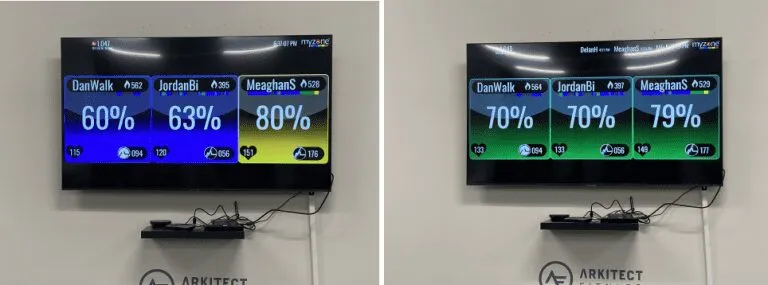By Andrew Merritt
If you have worn any kind of fitness tracker or smartwatch in the last decade,
chances are you have seen a reading of what your heart rate is at any given
moment. But what does that number mean? And how can you use that information to
help you get better results? Keep reading to find out!
To start off, let’s go over what your heart rate is. Measured in beats per
minute, your heart rate is the number of times that your heart beats per minute to
deliver oxygen and other nutrients throughout your body. Your resting heart rate
(RHR) measures how many times your heart beats per minute while at rest, and
normally falls between 60-100 beats per minute; while your maximum heart rate
(MHR) is the fastest your heart is capable of beating in one minute and can be
roughly calculated by subtracting your age from 220. For example, if you were 30
years old, your theoretical maximum heart rate would be 190 beats per minute. Both
of these can be affected by several factors, such as your age, sex, body weight,
physical fitness, and environmental conditions such as weather or altitude.
Now that we’ve gone over the basics of what your heart rate is, let’s talk about
how you can use this information to make the most of your workouts. When you are working out, your heart rate will fall into one of five distinct zones depending on the intensity of the workout.
- Zone 1: Very Light Intensity, 50-60% of your max heart rate. In this zone,
you’re getting your body moving with minimal stress and exertion. This zone
might be used for an easy training day, warming up or cooling down. - Zone 2: Light Intensity, 60-70% of your max heart rate, This zone is for longer
training sessions. You can sustain this basic-effort zone for a long time, yet
still chitchat a little bit with a coach or workout partner. - Zone 3: Moderate intensity, 70-80% of your max heart rate. This is where you
start to challenge yourself and get out of your comfort zone, but not
challenging enough that you can’t sustain it. It’s comfortably uncomfortable. - Zone 4: High Intensity, 80-90% of your max heart rate. This zone is where the
going gets tough. Muscle fatigue starts to set in, your breathing gets heavier,
and talking becomes very difficult. - Zone 5: Maximum Intensity, 90-100% of your max heart rate. This zone is for
all-out effort and is only maintained for short durations, as your muscles are
working at their maximum capacity.
There are benefits to training in each zone, and how long you spend in each zone depends on what your goals are and your current level of fitness. Spending time in Zones 1&2 will build up your general endurance and cardiovascular health. Training at these levels of intensity will also promote blood flow to muscles, which will improve your ability to recover, between both workouts and individual sets/intervals. These zones are also great for beginners since the effort is easier to maintain, isn’t too taxing physically, and will help build a good base for future harder workouts. Moving up to Zone 3 is where exercise becomes more vigorous. This could be either cardiovascular exercise such as running or cycling or lifting weights. Training in this zone will lead to aerobic fitness benefits just like Zones 1&2, and increased muscle endurance, which will allow you to sustain your efforts for longer periods of time. Beginners will find their way to Zone 3 pretty quickly but will have to work a little harder than more experienced trainees to stay there.
As you start to increase the intensity of your cardiovascular exercise and lift heavier weights, you will move into Zone 4. Training in Zone 4 will increase muscular power, as well as improve your anaerobic threshold, which is a measure of when muscular fatigue starts to set in. In other words, training around this threshold will help you exercise at higher intensities without getting tired. More experienced trainees will have to work harder to stay in Zone 4, as their bodies are more adapted to high-intensity exercise. Lastly, as you increase your intensity to the all-out effort, you will transition into Zone 5 and will be training closer to your max heart rate. You won’t get the same aerobic and endurance benefits as the lower zones, but at this high of an intensity, your body will improve its ability to recruit more muscle fibers and use them more effectively during exercise.
For most people, training between Zones 2-4 will have the most benefits, as you can improve multiple qualities of fitness without pushing yourself to intensities that are difficult to maintain. This is where training with a heart rate monitor, such as the MyZone monitors we use at Arkitect Fitness, can be very useful.
With the MyZone monitors streaming your heart rate directly to the TV in the gym, you (and your coaches) can easily look up and see what zone you’re training in. Maybe you think you’re working as hard as you can but you look up and see you’re only in Zone 2. Or perhaps you think you’re going for a casual cruise on the Air Bike to cool down but look at the TV and find out you’ve been hanging out in Zone 4. In either case, you can get real-time feedback on your exercise intensity and adjust your effort accordingly. You can also utilize the MyZone monitors to properly recover between sets. Let’s say you just finished a hard set of squats and are in Zone 4. Instead of guessing when you are recovered and ready for the next set, you can check out the MyZone display and confirm that you’re ready to go again, or if you need to rest a little longer.
Regardless of your goals or fitness level, there are many benefits to training with a heart rate monitor and paying attention to what zone you are in. If you have any questions on how to utilize heart rate training in your program, or you would like to get set up with a MyZone monitor, talk to a coach next time you are in the gym.




